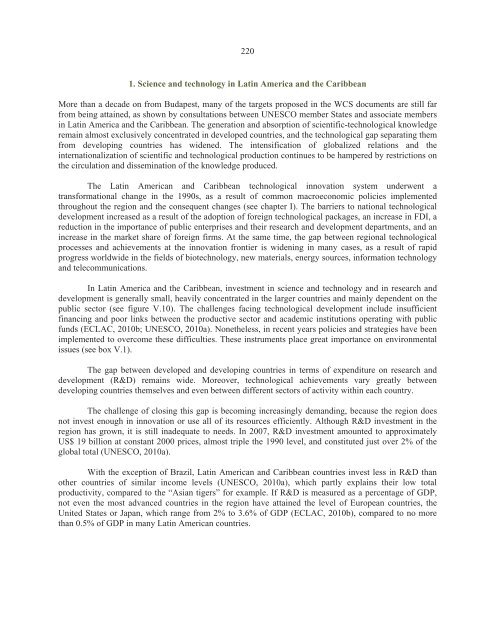sustainable development 20 years on from the ... - José Eli da Veiga
sustainable development 20 years on from the ... - José Eli da Veiga
sustainable development 20 years on from the ... - José Eli da Veiga
Create successful ePaper yourself
Turn your PDF publications into a flip-book with our unique Google optimized e-Paper software.
2<str<strong>on</strong>g>20</str<strong>on</strong>g><br />
1. Science and technology in Latin America and <strong>the</strong> Caribbean<br />
More than a decade <strong>on</strong> <strong>from</strong> Bu<strong>da</strong>pest, many of <strong>the</strong> targets proposed in <strong>the</strong> WCS documents are still far<br />
<strong>from</strong> being attained, as shown by c<strong>on</strong>sultati<strong>on</strong>s between UNESCO member States and associate members<br />
in Latin America and <strong>the</strong> Caribbean. The generati<strong>on</strong> and absorpti<strong>on</strong> of scientific-technological knowledge<br />
remain almost exclusively c<strong>on</strong>centrated in developed countries, and <strong>the</strong> technological gap separating <strong>the</strong>m<br />
<strong>from</strong> developing countries has widened. The intensificati<strong>on</strong> of globalized relati<strong>on</strong>s and <strong>the</strong><br />
internati<strong>on</strong>alizati<strong>on</strong> of scientific and technological producti<strong>on</strong> c<strong>on</strong>tinues to be hampered by restricti<strong>on</strong>s <strong>on</strong><br />
<strong>the</strong> circulati<strong>on</strong> and disseminati<strong>on</strong> of <strong>the</strong> knowledge produced.<br />
The Latin American and Caribbean technological innovati<strong>on</strong> system underwent a<br />
transformati<strong>on</strong>al change in <strong>the</strong> 1990s, as a result of comm<strong>on</strong> macroec<strong>on</strong>omic policies implemented<br />
throughout <strong>the</strong> regi<strong>on</strong> and <strong>the</strong> c<strong>on</strong>sequent changes (see chapter I). The barriers to nati<strong>on</strong>al technological<br />
<str<strong>on</strong>g>development</str<strong>on</strong>g> increased as a result of <strong>the</strong> adopti<strong>on</strong> of foreign technological packages, an increase in FDI, a<br />
reducti<strong>on</strong> in <strong>the</strong> importance of public enterprises and <strong>the</strong>ir research and <str<strong>on</strong>g>development</str<strong>on</strong>g> departments, and an<br />
increase in <strong>the</strong> market share of foreign firms. At <strong>the</strong> same time, <strong>the</strong> gap between regi<strong>on</strong>al technological<br />
processes and achievements at <strong>the</strong> innovati<strong>on</strong> fr<strong>on</strong>tier is widening in many cases, as a result of rapid<br />
progress worldwide in <strong>the</strong> fields of biotechnology, new materials, energy sources, informati<strong>on</strong> technology<br />
and telecommunicati<strong>on</strong>s.<br />
In Latin America and <strong>the</strong> Caribbean, investment in science and technology and in research and<br />
<str<strong>on</strong>g>development</str<strong>on</strong>g> is generally small, heavily c<strong>on</strong>centrated in <strong>the</strong> larger countries and mainly dependent <strong>on</strong> <strong>the</strong><br />
public sector (see figure V.10). The challenges facing technological <str<strong>on</strong>g>development</str<strong>on</strong>g> include insufficient<br />
financing and poor links between <strong>the</strong> productive sector and academic instituti<strong>on</strong>s operating with public<br />
funds (ECLAC, <str<strong>on</strong>g>20</str<strong>on</strong>g>10b; UNESCO, <str<strong>on</strong>g>20</str<strong>on</strong>g>10a). N<strong>on</strong>e<strong>the</strong>less, in recent <str<strong>on</strong>g>years</str<strong>on</strong>g> policies and strategies have been<br />
implemented to overcome <strong>the</strong>se difficulties. These instruments place great importance <strong>on</strong> envir<strong>on</strong>mental<br />
issues (see box V.1).<br />
The gap between developed and developing countries in terms of expenditure <strong>on</strong> research and<br />
<str<strong>on</strong>g>development</str<strong>on</strong>g> (R&D) remains wide. Moreover, technological achievements vary greatly between<br />
developing countries <strong>the</strong>mselves and even between different sectors of activity within each country.<br />
The challenge of closing this gap is becoming increasingly demanding, because <strong>the</strong> regi<strong>on</strong> does<br />
not invest enough in innovati<strong>on</strong> or use all of its resources efficiently. Although R&D investment in <strong>the</strong><br />
regi<strong>on</strong> has grown, it is still inadequate to needs. In <str<strong>on</strong>g>20</str<strong>on</strong>g>07, R&D investment amounted to approximately<br />
US$ 19 billi<strong>on</strong> at c<strong>on</strong>stant <str<strong>on</strong>g>20</str<strong>on</strong>g>00 prices, almost triple <strong>the</strong> 1990 level, and c<strong>on</strong>stituted just over 2% of <strong>the</strong><br />
global total (UNESCO, <str<strong>on</strong>g>20</str<strong>on</strong>g>10a).<br />
With <strong>the</strong> excepti<strong>on</strong> of Brazil, Latin American and Caribbean countries invest less in R&D than<br />
o<strong>the</strong>r countries of similar income levels (UNESCO, <str<strong>on</strong>g>20</str<strong>on</strong>g>10a), which partly explains <strong>the</strong>ir low total<br />
productivity, compared to <strong>the</strong> “Asian tigers” for example. If R&D is measured as a percentage of GDP,<br />
not even <strong>the</strong> most advanced countries in <strong>the</strong> regi<strong>on</strong> have attained <strong>the</strong> level of European countries, <strong>the</strong><br />
United States or Japan, which range <strong>from</strong> 2% to 3.6% of GDP (ECLAC, <str<strong>on</strong>g>20</str<strong>on</strong>g>10b), compared to no more<br />
than 0.5% of GDP in many Latin American countries.













